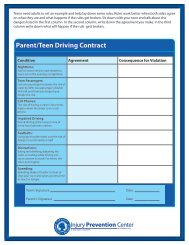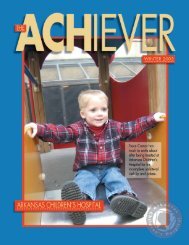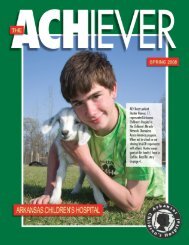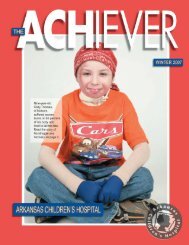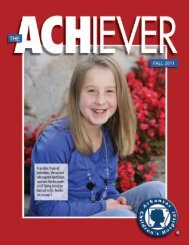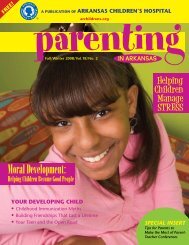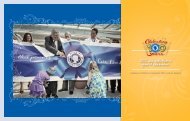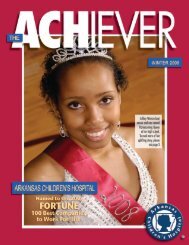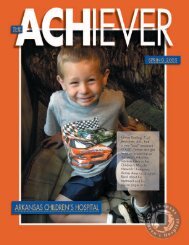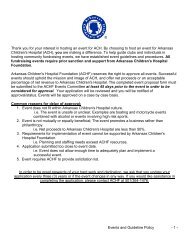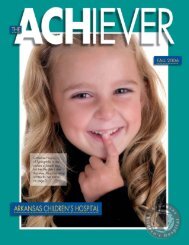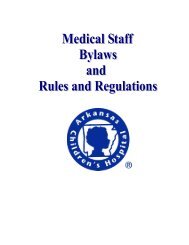2009 Natural Wonders report - Arkansas Children's Hospital
2009 Natural Wonders report - Arkansas Children's Hospital
2009 Natural Wonders report - Arkansas Children's Hospital
You also want an ePaper? Increase the reach of your titles
YUMPU automatically turns print PDFs into web optimized ePapers that Google loves.
2008 2ND EDITION
Table of ContentsABOUT THE COUNCIL 2<strong>Natural</strong> <strong>Wonders</strong> Partnership Council Representative 2INTRODUCTION 3ACHIEVING SUCCESS EARLY 4Injury Prevention Center 4Obesity Prevention 4Dental Care 5ENGAGING THE PUBLIC 6Phone Survey 6Study Circles 6Provider Focus Groups 7Informant Interviews 7SETTING THE STAGE 8Detriments of the Child Health and Development Context 8RECOMMENDATIONS 9Prenatal Care, Infant Mortality and Teen Pregnancy 10Immunizations 11Oral Health 11Reducing Risky Behavior —Injury Prevention 12Tobacco Prevention 13Obesity Prevention 13Mental Health Services 14Service Needs or Expansions 15Capacity Building 16A DISTINCT PRIORITY 17REFERENCES 18List of Abbreviations 18Public Engagement Map 20
2ABOUT THE COUNCILAbout the CouncilThe <strong>Natural</strong> <strong>Wonders</strong> Partnership Council (NWPC), composed oforganizations that serve children, was originally convened by <strong>Arkansas</strong>Children’s <strong>Hospital</strong> (ACH) to identify the health needs of the state’schildren and to construct a strategic plan for improving their health andquality of life. For almost 100 years, ACH has provided world class healthcare for <strong>Arkansas</strong>’ children. Long seen as a leader and innovator, it wasonly natural that ACH would convene a group of partners to address criticalchildren’s health issues. The ACH Board of Directors and hospital leadershave committed both time and resources to developing the plan and areeager to see it implemented. ACH generously funded the informationgatheringstage of the Council’s work culminating in thisrecommendations <strong>report</strong>.Leading the Council’s efforts are Dr. Jonathan Bates,CEO of <strong>Arkansas</strong> Children’s <strong>Hospital</strong>, Chair, and FirstLady of <strong>Arkansas</strong>, Ginger Beebe, Honorary Chair.NATURAL WONDERS PARTNERSHIP COUNCIL REPRESENTATIVESMary Aitken, M.D.<strong>Arkansas</strong> Children’s <strong>Hospital</strong>C.A.R.E.Director of the Injury Prevention Center at ACHJonathan Bates, M.D.President and Chief Executive Officer<strong>Arkansas</strong> Children’s <strong>Hospital</strong>Aimee BerryExecutive Director<strong>Arkansas</strong> Chapter American Academy of PediatricsWynona Bryant-Williams, Ph.D.Executive Director<strong>Arkansas</strong> Minority Health CommissionElisabeth Wright BurakHealth Care Policy Director<strong>Arkansas</strong> Advocates for Children and FamiliesDee CoxCoordinator Special Programs<strong>Arkansas</strong> Dept. of EducationJoyce DeesGovernor’s Office LiaisonDept. of Health and Dept. of Human ServicesJennifer Dillaha, M.D., M.P.H.Director Center for Health AdvancementDepartment of HealthScott GordonExecutive Vice President<strong>Arkansas</strong> Children’s <strong>Hospital</strong>Martha Hiett<strong>Arkansas</strong> Dept. of Human Services, Division ofChild Care and Early Childhood EducationMichaela HillAssistant to First Lady, Ginger BeebeJanie HuddlestonDeputy DirectorDept. of Human ServicesRich HuddlestonExecutive Director<strong>Arkansas</strong> Advocates for Children and FamiliesTom Kimbrell, Ed.D.Executive Director<strong>Arkansas</strong> Association of Education AdministratorsRichard Leithiser, M.D.<strong>Arkansas</strong> Children’s <strong>Hospital</strong> Pediatric RadiologyBetty A. Lowe. M.D.Emeritus, <strong>Arkansas</strong> Children’s <strong>Hospital</strong> BoardEduardo Ochoa, M.D.President<strong>Arkansas</strong> Chapter, American Academy of PediatricsMartha Phillips, Ph.D., M.P.H., MBAUAMS–Dept. of Psychiatry (Medicine) andEpidemiology (Public Health)Chris PyleDelta Dental of <strong>Arkansas</strong>Jim Raczynski, Ph.D.Dean, College of Public HealthAmy Rossi, LCSWAssociate Director<strong>Arkansas</strong> Center for Health ImprovementTonya RussellDirector<strong>Arkansas</strong> Dept. of Human Services, Divisionof Child Care and Early Childhood EducationRhonda SandersExecutive Director<strong>Arkansas</strong> Hunger Relief AllianceWarren Skaug, M.D.The Children’s Clinic of JonesboroRosi Smith<strong>Arkansas</strong> Children’s <strong>Hospital</strong> Government RelationsDr. Steven Strode<strong>Arkansas</strong> Chapter, Association of FamilyPractice PhysiciansGary Wheeler, M.D.<strong>Arkansas</strong> Children’s <strong>Hospital</strong> Infectious DiseasesJudge Joyce Williams WarrenPulaski County Juvenile CourtElaine WoottenCollege of Public HealthDawn Jaycox ZekisDirectorPolicy and Planning, <strong>Arkansas</strong> Dept.of Human ServicesFor further information or to request a copy of this <strong>report</strong>,contact the <strong>Natural</strong> <strong>Wonders</strong> Partnership Council via email atnaturalwonders@archildrens.org or via telephone at 501-364-9916.
INTRODUCTION3IntroductionIn early 2006, the leadership of <strong>Arkansas</strong> Children’s <strong>Hospital</strong> (ACH)convened a small group of community partners to discuss thecontinuing problems of poor socio-economic and health outcomes forchildren. They asked how they might play a larger role in changinghealth outcomes for children beyond the clinical intervention usuallycontained within the walls of their institutions. Partners weredelighted to have the hospital leadership express an interest in publicpolicy and finding ways to change the social determinants of health.From that initial discussion, the parties decided that a new explorationand documentation of the best statistical evidence <strong>report</strong>ing thehealth and well-being of children should be compiled. In summer 2007,a <strong>report</strong> titled “<strong>Natural</strong> <strong>Wonders</strong>: The State of Children’s Health in<strong>Arkansas</strong>” was distributed widely throughout the state describing thestatus of child health in <strong>Arkansas</strong>. The <strong>report</strong> was saluted by Governorand Mrs. Beebe, and several thousand copies were distributedthroughout the state. Upon its release, ACH President and CEO,Dr. Jonathan Bates promised that the hospital and its communitypartners would not shelve the <strong>report</strong> but use it as the springboard fora strategic plan to improve child health and well-being. To that end,the original small group of partners expanded their membership andformalized their group to be called the <strong>Natural</strong> <strong>Wonders</strong> PartnershipCouncil (NWPC), chaired by Dr. Bates and assisted by <strong>Arkansas</strong> FirstLady Ginger Beebe as honorary co-chair.The first <strong>Natural</strong> <strong>Wonders</strong> <strong>report</strong> responded to the ACH and AmericanAcademy of Pediatrics (AAP) mission statements. It attempted toidentify parameters of health as related to social determinants ofhealth. In this second iteration of information to inform and improveconditions of child health in <strong>Arkansas</strong>, the NWPC is adopting theframework of the AAP’s recently revised and improved BrightFutures 1 principles, strategies and tools. Bright Futures employsan ideology that respects both the promotion and the preventionaspects of child health, as well as the clinical practice elements, andutilizes the interface between physician, child (family), communityand environment. The development of Bright Futures was facilitatedby an interdisciplinary group of experts from the federal and privatesectors. It is based on a developmental approach that acknowledgesthe constant change or interplay in a child’s needs, strengths,weaknesses, relationships and experiences as they grow, learnand develop. We believe this framework provides a way to bothillustrate and explain our recommendations while also establishinga framework for <strong>report</strong>ing progress on the health outcomes we arehoping to influence.Although the first <strong>report</strong> acknowledged problems facing the state’schildren and suggested a number of steps to improve that status,the NWPC felt more was needed. We agreed to spend the nextyear examining the issues identified in the first <strong>report</strong>. The publicwas engaged to determine their opinions on the most importantthings to do to improve child health and well-being in <strong>Arkansas</strong>,with consideration given to identifying issues that might be moreimportant for one geographic area than another. This explorationwas very thorough and was conducted in record time. The NWPC meton a monthly basis to oversee the public engagement process, toshare information about efforts underway to improve conditions forchildren and to engage in new partnerships that could tackle problemsimmediately. Attendance at these meetings was high, with very fewabsences at any given meeting. That in itself is testimony of theimportance the meetings held for members, all of whom are leaderswith little time to spare.To obtain the detailed results and data associated withthe various focus groups, surveys and Study Circleevents, please access the <strong>Natural</strong> <strong>Wonders</strong> websiteat www.archildrens.org/<strong>Natural</strong><strong>Wonders</strong>.
4ACHIEVING SUCCESS EARLYAchieving Success EarlyData from the <strong>Natural</strong> <strong>Wonders</strong> <strong>report</strong> 2 acknowledged that thestate mortality rates in children 1–14 years of age were 20–30%higher than the national average due largely to increased fatalities intransportation accidents. Other striking deficiencies in health statusidentified were: in obesity where 40% of fifth graders are overweightor at risk of being overweight; in dental care where only 15% of youngchildren and 17% of teens have had preventive sealant applied totheir teeth and just 62% of Arkansans drink fluoridated water. Thesestartling negative standings led some members to move immediatelyfor solutions.Early activities of the IPC include expanding motor vehicle occupantsafety to encompass teen drivers, including establishment of astatewide coalition examining potential impacts of laws governingdriver’s licenses, seatbelts and helmets. Additionally, Dr. Aitken andher team have conducted focus groups regarding these and otherinjury prevention topics that have helped inform the work of the NWPCand this year’s <strong>report</strong>.I N J U R Y P R E V E N T I O N C E N T E RDr. Mary Aitken, a member of the NWPC, has long been an advocatefor improving the state’s high rate of childhood injury and death frominjuries, particularly motor vehicle crashes. She presented strongevidence to the NWPC that most of the fatalities and serious injurieswere preventable if certain safeguards were put in place and policychanges were made. Her discussion and paper spawned keen interestfrom ACH, and the hospital decided to award Dr. Aitken a start-upgrant to launch the Injury Prevention Center (IPC).The overall goals of the IPC are:• Improving the health status of children of the state asinjury-related morbidity and mortality rates are reduced;• Fostering collaboration to increase utilization andeffectiveness of existing and future prevention strategies;• Evaluating programs and promoting research into newsolutions; and• Establishing centralized planning and coordination foremerging injury prevention endeavors.OBESITY PREVENTIONSpurred by membership on the NWPC, the <strong>Arkansas</strong> Blue & YouFoundation and ACH jointly funded a competitive request for proposalsthat led to two papers and a state summit on obesity. The paperswere to inform the people throughout the state. The <strong>Arkansas</strong>Advocates for Children and Families and the <strong>Arkansas</strong> Center forHealth Improvement compiled the two <strong>report</strong>s, which were providedto the funders in July. Preliminary findings from the <strong>report</strong>s werepresented to state leaders at an obesity policy summit in May. Theobesity policy summit assembled stakeholders in order to developa new plan for moving the state from halting progression of obesityrates among children to actually reducing the rates. Policy prioritieswere decided at the summit and workgroups are forming to executethe recommendations. (See summary on the web in Appendix G.)
ACHIEVING SUCCESS EARLY5DENTAL CARESeveral NWPC members formed a small investigatory committeeto determine what could be done to increase dental services tochildren in the state. They initially focused on the low rate of childrenreceiving sealants and found a way to increase access to dental careas well as application of sealants in two underserved areas of thestate. Using the strength of the participating NWPC members (DeltaDental, <strong>Arkansas</strong> Dental Association, the <strong>Arkansas</strong> Dental HygienistsAssociation, <strong>Arkansas</strong> Department of Health and ACH, with financialsupporters Tyson Foundation and Ronald McDonald House Charities)the following remedies have been set in motion: increased children’sdental services during the Mission of Mercy free dental clinic inMay 2008 to serve 1,569 individuals with more than 100 of thesebeing children; and began an application process with local RonaldMcDonald House Charities chapters to secure two mobile units fromMcDonald’s Global Charities for delivering restorative and preventivedental services, including sealants. These units are scheduled for usein the central and northwest areas of the state. Additionally, ACH isworking with the <strong>Arkansas</strong> Department of Health to expand a dentalsealant program for children across the state. The Wakefield DentalClinic in Little Rock, at Wakefield Elementary School, continues to seeincreasing numbers of children, with six schools bussing children intothe clinic for care.Discussions continue for adoption of policies to fluoridate public watersupplies in areas not served; to change scope of work policies to allowother health care professionals, using proper guidelines and qualityapproaches, to administer sealants and to secure reimbursementsfor such; engagement of a variety of efforts to eliminate the use ofsmokeless tobacco; and exploration of starting a dental school.
6ENGAGING THE PUBLICEngaging the PublicACH generously provided the funds to underwrite four differentmethods to involve the public in providing information for a strategicplan to improve child health and well-being. <strong>Arkansas</strong> Advocatesfor Children and Families, author of the original <strong>Natural</strong> <strong>Wonders</strong>statistical <strong>report</strong>, directed two efforts. One was the phone survey ofover 2000 households in <strong>Arkansas</strong>. The other was to conduct StudyCircles with assistance from the <strong>Arkansas</strong> School Board Associationin five communities in <strong>Arkansas</strong>.PHONE SURVEYThe phone survey was conducted in the fall of 2007 and findings were<strong>report</strong>ed in January 2008. The public generally concurred with thestatistical findings with one exception. Survey respondents were veryconcerned about uninsured children or those without access to healthcare due to escalating costs. While <strong>Arkansas</strong> has greatly reducedthe number of children without health insurance (from a high of 24%to currently less than 10%) with the adoption of ARKids First, thenational debate about reauthorizing SCHIP (the federal program tohelp uninsured children) was raging in the media during the time ofthe survey and may have helped create a more acute public realizationabout the plight of those without health care. And, as surveysoften do, this series of questions invoked lots of comments fromrespondents regarding the cost of health care and their concern abouttheir own vulnerability for meeting deductibles or retaining coverage.(See summary on the web in Appendix B.)in children was also cited as a serious problem by a largenumber of respondents, as was teen pregnancy.• Respondents were asked to give their opinion on severalstatements. When asked about <strong>Arkansas</strong>’ child welfaresystem, respondents showed a serious lack of knowledge.However, when read statements about family access to healthcare, a large percentage agreed that low-income familieshave less access to health care. And, while overall, only 37%of respondents agreed that minority children have less accessto health care, 72% of African American respondents agreedwith that same statement.• Respondents also showed an interest in finding alternativesto the problem of health care access. Ideas such as well-childvisits and health screens in schools received high marks, asdid stricter laws regarding teenage driving.Some of the additional findings from the survey were:• When asked about the biggest problems <strong>Arkansas</strong> faces withregard to children’s health and well-being, an overwhelmingmajority cited the low quality, cost of and lack of healthinsurance.• When asked to rate their community on a variety of issues,respondents gave the lowest marks to their community’sability to serve children with learning disabilities anddiscipline problems. The highest marks were given foreducation and quality pre-K for 3- and 4-year-olds.• When asked to rank their community on providing a safeenvironment, respondents in the southeast region of thestate gave much lower marks than other areas. For the samequestion, African Americans more than whites ranked theircommunities as unsafe.• When asked to rate the seriousness of specific problems intheir community, overweight children was cited as a seriousto moderate problem by 77% of respondents. Substance abuseSTUDY CIRCLESThe Study Circle process was to facilitate a deliberative discussionto explore the issues and to engage a diverse group of communitymembers to identify problems and seek solutions. The conversationshad a structured discussion guide and trained facilitators thatmanaged the process and helped the group arrive at solutions.The discussion sessions occurred over four or five consecutiveweeks and included groups of eight to 10 individuals. A discussionsite might have had multiple groups while others may have had onlyone. Five communities in each respective state health departmentregion participated, and their contributions were recorded in a <strong>report</strong>delivered to the NWPC. (See summary on the web in Appendix C.)
ENGAGING THE PUBLIC7Some of the Study Circle findings were: When asked to grade a varietyof services in their communities, health care routinely received a gradeof “D.” Participants spoke of lack of access to care, too few providersand little or no dental care for children. They expressed concern abouthealth care costs, especially medicines. Aside from providing financialincentives to get doctors to move to rural areas or building health andwellness facilities, the most popular remedy suggested for improvingchildren’s health and increasing access to quality care was to provideschool-based health services. Although the topics of family andcommunity were not graded during the third discussion session, thetopics were two of the most cited concerns among circle participants.In fact, all five discussion group <strong>report</strong>s mentioned the breakdownof the family structure as a big problem in their communities, andeach expressed concern over the lack of parental responsibility andaccountability.* Four of the groups mentioned that parents todaylacked parenting skills.Study Circle participants were asked to discuss their vision withregard to improved health and well-being of children. Most of themexpressed visions reflecting the groups’ concerns for better healthcare for all children; equal opportunities for all citizens despite race,ethnicity or social class; more accountability in the social servicessystems; a fairer distribution of resources; and strengtheningfamilies in their communities.PROVIDER FOCUS GROUPSThe <strong>Arkansas</strong> Chapter of the American Academy of Pediatricsconducted focus groups with an array of different child-serving clinicalproviders in five areas of the state. These focus groups were wellattended with no fewer than 10 participants in every discussion. Theparticipants consistently thanked the Academy for soliciting their inputand wanted to know when the <strong>report</strong> would be ready and when wouldthey return to help solve the identified problems. (See summary on theweb in Appendix D.)The overwhelming issue raised by participants was concern aboutparents, including lack of involvement with their children, limitedlevels of education and limited financial resources. The participatingproviders seemed to agree that the parental component was thecatalyst for creating “hot-button” issues such as the obesity epidemic,lack of preventive care and dental care, teen pregnancy and riseof sexually transmitted diseases. When asked to consider barriersthat prevent providers from effectively treating children, they citeddifficulty with navigating the Medicaid system (as well as other payersystems), lack of availability of specialists and an increase in patientloads. Language/communication barriers also were mentioned byeach group, with specific reference to the lack of providers fromminority communities (both African American and Latino).INFORMANT INTERVIEWSThe University of <strong>Arkansas</strong> for Medical Sciences College of PublicHealth completed the final engagement of stakeholders by conductingsmall group or individual interviews statewide with academicianswho specialized in content areas that had some relation to children’shealth. Faculty members’ comments were mostly similar to thoseof other participants in public engagement projects. They <strong>report</strong>edpoverty and education levels as a constant deterrent to healthimprovement. Instead of a lack of dental services rising as a topissue, however, these professionals expressed more concern over thelack of mental health services. They observed that parents often didnot link dental services to overall health and that they opted not totake children to a dentist because of cost, a lack of knowledge aboutits preventive health benefit and its relative lack of urgency amongcompeting priorities. Obesity and substance abuse were two oftencited problems suffered by children. Two faculty groups made specificreferences to the impact on children of parents’ manufacture and useof crystal methamphetamine in the home. Faculty members in almostevery group expressed frustration at the absence of a central pointfor the collection and maintenance of data related to children’s health,complicating efforts to apply for funding and conduct research leadingto health improvement. This is not dissimilar from the informationin the Study Circles where community members talked about thedifficulty of finding out information about their communities withregard to data and how to find services. (See summary on the web inAppendix E.)* Problems mentioned included the lack of family “together time,” both parents working,single parent households and grandparents raising grandchildren.
8SETTING THE STAGESetting the StageThe NWPC adopted both a definition of health and a conceptualframework with which to guide the development of a strategic planfor improving child health. The diversity of NWPC membership, andthe need to involve multiple sectors to tackle the problems, motivatedmembers to develop language that everyone would understand andembrace. The Council understood that its work was not exclusive andthat there were other stakeholders who were undertaking separateefforts on health issues of concern to children. Thus, members alsoreviewed and incorporated work by other panels undertaking similartasks. They did not find a need to create new tools if others wereavailable and met the needs. The NWPC adopted the definition forchild health recommended in 2004 by the Committee on Evaluationof Children’s Health, National Research Council of the Institute ofMedicine (IOM). 3The definition of child health adopted by the NWPC is identical to theIOM definition with one addition noted within: “Children’s health isthe extent to which individual children or groups of children are ableor enabled to (a) develop and realize their potential, (b) satisfy theirneeds, and (c) develop the capacities that allow them to interactsuccessfully [and responsibly] with their biological, physical, andsocial environments.”Additionally, the NWPC endorsed the revised update of the AmericanAcademy of Pediatrics’ “Bright Futures” 5 approach to healthservice delivery.The AAP explanation of Bright Futures is: “Bright Futures is a setof principles, strategies, and tools that are theory based, evidencedriven, and systems oriented that can be used to improve thehealth and well-being of all children through culturally appropriateinterventions that address their current and emerging healthpromotion needs at the family, clinical practice, community, healthsystem, and policy levels.” AAP 2007.Finally, the NWPC determined that an illustration provided by acollaborative effort of the 15 member states of the European UnionHealth Monitoring Programme—CHILD: Child Health Indicators ofLife and Development—is a good model to explain the context forreviewing, refining and <strong>report</strong>ing progress in improving and sustaininga quality of life that gives a child optimal advantages. 4UNEMPLOYMENTDetriments of the Child Health and Development ContextDEFICIENT LAWSOCIALLYISOLATED LIVINGHARMFULENVIRONMENTSCHOOLSOCIAL LIFEFINANCIAL SUPPORTTO FAMILIESPOVERTYLACK OFDAY CAREDAY CAREParenting conditions forpositive child health anddevelopmentUNCERTAINFUTURE PROSPECTSLACK OF INFLUENCEAND PARTICIPATIONSOCIAL SERVICESHEALTH CARECHILD-ORIENTEDCULTUREADVERSE CULTURALDEVELOPMENTThe overall determinants of the child health and development contextcan be illustrated as shown in the figure above. 5 This is the domainwhich the CHILD Project sought to address, with a particular focus onresponsibilities within the health sector, but with a strong inter-sectoralviewpoint as to other policy and service responsibilities, too.The NWPC organized its activities in three strategic phases:1) data gathering to build evidence of the problems; 2)publicengagement to determine public interest and seek recognitionof issues; 3) recommendation setting and implementation. This<strong>report</strong> represents the third and final phase. The NWPC deliberatelydetermined that the information-gathering and priority-setting phaseswould be time-limited. Its overall goal was to set a strategic visionfor the state and to lay a foundation from which to build an actionagenda that would emphasize improvement and involve multiplestakeholders including parents, children, private and public sectors,faith communities, civic organizations and decision leaders.It is important to provide these points of reference as the context usedby NWPC to guide the implementation period for its recommendations.The terms provide essential starting points from which a variety ofindividual, community, and governmental stakeholders can find a wayto engage in the big job ahead.NEGATIVEMARKET FORCESDISEASEAND INJURYNEGATIVE MEDIA
10RECOMMENDATIONSPRENATAL CARE, INFANT MORTALITY ANDTEEN PREGNANCYAlthough prenatal care has been improving significantly over the lastdecade, the news about birthweight and infant mortality is not good.Rates for both low birthweight and infant mortality exceed nationalaverages at 8.6% of all births and 8.3 per 1,000 births respectively.Particularly disturbing is the higher rate of infant mortality for AfricanAmerican babies compared to white babies. In 2002, there were 13.8deaths per 1,000 live births for African American babies compared to7.2 deaths per 1,000 live births for white babies. Too many teens arestill having babies in <strong>Arkansas</strong> at a rate of 15.5% of all births in 2002compared to the national rate of 10.8%.All mothers receive prenatal care as early as the firsttrimester until birth. All babies are born healthy andsurvive the first year of life, and receive well-childvisits to monitor developmental benchmarks toaddress problems before they become life-threateningor debilitating. Teens delay bearing children until theyare self-sustaining adults.Recommendations• Improve promotion of prenatal care among minority women andteens by increasing access to Medicaid and assuring access forprenatal health services. Access to obstetrical services in ruralareas must be solved with further development of the UAMS Angelsprogram and other innovative service delivery strategies by nursepractitioners, telemedicine, and school and communityhealth centers.• Increase programs that discourage and/or prevent teen pregnancy.• Ensure access to education completion for teens who becomepregnant while still in school.• Provide job training and placement services for teen parents.• Provide school-linked after-school and summer programs thatcontain social, emotional and life-skills-building to include drug andviolence prevention, youth leadership and character education. Theprograms should promote physical activity, proper nutrition andhealthy lifestyles that include recreational and sport activities.*• Expand Access to Substance Abuse Treatment for PregnantWomen, Mothers with Children and Children/Adolescents** bysecuring at least $10 million in state funding to allow <strong>Arkansas</strong> toaccess federal Medicaid dollars for substance abuse treatment.• All children birth to 5 should receive developmental screening aspart of comprehensive well-child examinations (otherwise knownas EPSDT screens) in the context of a medical home. This can beaccomplished by:(1) Increasing care coordination capacity to support familiesand providers,(2) Planning for future use of fiscal incentives for EPSDTproviders, and(3) Mandating use of a consistent and evidence-drivendevelopmental screening tool.***• Increase Medicaid EPSDT screening rates to national levelsof attainment.*Governor’s Task Force on Best Practices for After-School and Summer Programs 8/08.**Adopted from the “Closing the Addiction Treatment Gap” Partnership.***Adopted from the Assuring Better Child Health Development (ABCD) Initiative FinalReport from <strong>Arkansas</strong>.• Increase availability of proven parenting education programs forboth teen moms and dads.• Utilize materials and programs that are affiliated with the AAP’sBright Futures program that help to build parent knowledge andto promote coordination of services to support families whileraising children.
RECOMMENDATIONS11IMMUNIZATIONSORAL HEALTHRates of childhood immunizations, particularly those occurring afterinfancy, have not been keeping pace with the rest of the country. Infact, laws passed in 2003 allowing parents to opt out of immunizingtheir children for philosophical reasons have contributed to a reducedemphasis on keeping children up-to-date on their immunizations.Those securing permission to not have their children immunized haveincreased annually since passage of the legislation, causing officialsto be concerned about potential outbreaks of communicable disease.Additionally, the modern myth linking immunizations to increasedrates of childhood autism is unfounded but has been perpetuatedin popular media.Too few children have access to dental services. A 2003 survey of7100 third graders found that 61% had evidence of current or pastcavities, 31% had untreated cavities, 21% needed routine dental careand 6% had urgent dental needs. 2 Preventable solutions to commondental problems in children could be achieved if more children hadapplications of dental sealants and fluoride varnish and lived incommunities with fluoridated water systems. Only 62% of <strong>Arkansas</strong>counties fluoridate the water systems.All children can access dental care no matter wherethey live or whether they can afford it.Infants, children, and adolescents are providedprotection from communicable disease i.e., measles,chicken pox, etc.Recommendations• Fluoridate public water systems statewide.Recommendations• Reduce immunization exemption usage.• Inform parents and the public about the risks and proven effectsof immunizations.• Increase rates of childhood immunizations to at least the nationalaverage by 2013 and aim to keep the state’s performance rateof childhood immunizations consistently in the top tier ofperforming states.• Encourage and monitor physician and parental adherence torecommended child and adolescent vaccine schedules.• Increase access to and utilization of the state’s immunization registry.• Secure policies that enable more children to receive fluoridevarnish, sealants and preventive dental services. The NWPC urgesconsideration of alternative means of delivering some preventivedental services but competent and quality service delivery mustbe assured. Utilization of health professionals such as physicianassistants, nurse practitioners and dental hygienists may be oneoption. However, this may require improving and expandinglicensure practices and regulations.• Increase mobile dental/medical offices to take services to isolatedand underserved areas of the state. Ensure that such services arereimbursed by Medicaid and other carriers for sustainability.• Expand school-based models of delivering preventive dentalservices in underserved areas of the state.
12RECOMMENDATIONS• Mandate primary seat belt law.• Fund and secure a statewide trauma system for serious injury.• Enforce laws that restrict/limit ATV riding on “roads.”• Re-instate helmet-wearing laws for those riding ATVs andmotorcycles.• Increase the rates of helmet use via educational materials,social messaging campaigns and city ordinances.R E D U C I N G R I S K Y B E H AV I O R — I N J U R YPREVENTIONThe number of <strong>Arkansas</strong> children dying from preventable injuriesexceeds the national average by up to 40%. In 2005, 63% of deathsfor children age 1–4 and 60% of deaths for those ages 5–18 were dueto unintentional injury. Transportation-related causes made up themajority of all injury-related deaths.Significant injuries to infants, children and teens arereduced or eliminated due to preventive steps takenby them and their parents.• Classify child car seats as durable medical equipment to ensureinsurance reimbursement initially for children with special needsand then expand to all children.• Incentivize with things such as health insurance discounts for thoseacting responsibly while riding/driving motor vehicles.• Provide coordinated injury prevention professional educationprograms for current and future health care professionals toimplement into practice.• Enhance statewide child passenger seat program to ensure parentalaccess to equipment and educational resources.• Increase partnerships with Coordinated School Health (a collaborationeffort among ADH, DOE and local school districts) to integrate injuryprevention curriculum into health and wellness education at school.• Support efforts of other coalitions and groups such as the Governor’sTraumatic Brain Injury Task Force in finding solutions to problemsfaced by families after injury.• Re-establish a statewide child fatality review team to monitor andimprove interventions.Recommendations• Secure a graduated driver’s license (GDL) to include the followingprovisions, which reflect the ideal implementation of a GDL policyper the Insurance Institute for Highway Safety:- Establish intermediate license stage for beginning drivers.- Set 16 years of age as the entry age for licensing to drive.- Ensure that learner’s permits are held for a minimum ofsix months.- Provide criteria for intermediate stage driver’s licenses forthose aged 16½ to 18 years old.- Restrict distracting factors during driving such as cell phonesand number of teen passengers per vehicle.- Mandate supervised driving during night hours(provide exceptions for school and work).
RECOMMENDATIONS13TOBACCO PREVENTIONTeenage smoking habits, as well as exposure to secondhand smoke, in<strong>Arkansas</strong> top the national average. Additionally, a growing number ofteens <strong>report</strong> the use of chewing tobacco and other forms of tobacco.Evidence supports the use of different policies that relate to teenmarketing, which can delay or prevent initial use of tobacco productsRecommendations• Expand the methods for transferring nutrition education/information to parents and children to include such things asrestaurant menu labeling.• Increase the “Safe Routes to School” initiatives that encouragesafe routes to walk or ride a bicycle from home to school and backfor children.• Promote the use of school physical activity facilities for communityuse beyond regular school hours.Tobacco use by children and teens is eliminated as istheir exposure to indirect smoke.Recommendations• Raise the excise tax on cigarettes and other tobacco products, aproven deterrent of teen smoking.• Increase PE and physical activity requirements during the academicday for all grades and ensure that all students are involved ratherthan offering only competitive team sports.• Expand safe paths/areas for walking and pedaling and playing inall residential areas. This may include changing city ordinances torequire that such areas be built, renovated or maintained.• Integrate nutrition education and physical activity options withinexisting school curricula on a daily basis for all grades.• Encourage media to discontinue portrayal of images of teensand adult actors or characters using tobacco products in films,cartoons, videos, music videos, electronic games and otherpromotional or entertainment venues.• Maintain and expand the state’s Clean Indoor Air Act of 2006 toall public indoor spaces.• Protect children from exposure to secondhand smoke in publicoutdoor spaces.OBESITY PREVENTIONAlmost 40% of <strong>Arkansas</strong> children are overweight or at risk forbecoming overweight. Overweight conditions emerging and continuingthroughout childhood often result in lifelong health risks that can lead toearly death. Electronic entertainment and the lack of safe accessibleareas to play are causing more children to limit or abstain fromphysical activity. Over-reliance on high-calorie fast food combinedwith lessened physical activity is provoking an increasing weight gainfor children and their parents. These rates of obesity are significantlyhigher for Hispanic/Latino and African American children.• Expand healthy food alternatives in concession stands atpublic events.• Investigate and reduce school liability for injuries occurring onschool property if a physical activity facility has been opened forcommunity access.• Provide incentives to local food stores to increase healthy,affordable food options.• Increase retail food and farmers markets in lower populationareas of rural <strong>Arkansas</strong> as well as in urban areas.The childhood obesity epidemic is eliminated in <strong>Arkansas</strong>.
16RECOMMENDATIONSCAPACITY BUILDINGThroughout these recommendations, the Council has suggestedadding, creating or improving services. During deliberations, theCouncil also paid close attention to those areas where improvementswere needed to build a cohesive, coordinated and practical array ofinterventions that would serve even the most isolated communityin our state. To do that, some of the following recommendationsaddress the need for different methods or timing of innovations thatwould jumpstart or increase productivity and quality in the deliveryof services to children and their families. At least three of the othergroups searching for solutions to issues influencing children haverecommended a position that serves as an information guide tohelp parents and providers find appropriate help when a child has aparticular need. These health navigator positions were recommendednot only for information and referral but also to assist parents infollowing up on making applications and getting in for appointments.Complex service systems and funding sources have created a maze ofrequirements and instructions that make even the most educated andtenacious parent fail to secure a needed resource for their child. Toomany parents are diverted and give up the pursuit before they securethe necessary assistance.Recommendations• Ensure that children have a medical home that can guide andcoordinate screening diagnosis and treatment. (See appendix Gon the web for definition of medical home.)• Explore novel methods for delivering routine preventive healthservices to families in a more expeditious and accessible mannersuch as using paraprofessionals or different sites such as mobilehealth clinics.• Create health information systems that can inform the parent, theprovider and the school in coordinating health services includingelectronic, web-based personal health records.• Use technological advances, such as telemedicine, to provide expertdiagnosis and treatment.• Develop electronic warning systems to ensure follow-up services,medications, etc. are provided when screens come back with resultsthat demand further attention.• Provide quality markers for providers so that parents are betterinformed about the care their child should receive and can beassured they are getting it.• Develop programs that recruit students, especially minoritystudents, in middle and high school into health career paths.
A DISTINCT PRIORITY17A Distinct PriorityThrough its year of work, and reflected in some of theserecommendations, the Council recognized that minority children oftenbear a disproportionately negative impact in health outcomes, riskfactors and service delivery. The Council is particularly concernedabout children in immigrant families. Whether these children areimmigrants themselves or are citizens of the United States withimmigrant parents, they face dual obstacles: a higher likelihoodof living in poverty and a lower likelihood that they may qualify forgovernment supports like Medicaid and Food Stamps. This may bedue to their immigrant status or programs that poorly penetrateimmigrant families with unique language and cultural backgrounds.Many groups acknowledge the higher death, disease and povertyrates for minority children, but few have established specific actionplans to reduce, mitigate or eliminate the disparities. We have madesome specific recommendations to improve access to services forminority children, and particularly children in immigrant families, butwe realize that this population deserves focused attention. In the nextyear, we intend to engage minority youth, parents and communities tohear their concerns and learn from their experiences to root furtherrecommendations on these issues. In addition, a separate committeeof our members will investigate interventions that have beensuccessful in achieving health equity for minority children. This groupwill then turn to a search for resources to adapt these successes in<strong>Arkansas</strong> communities. The next <strong>report</strong> of the Council will contain asynthesis of this information and identify specific action steps that thestate and other stakeholders should take to improve health outcomesfor minority children. We recognize this is a critical step to improvethe health of all children in <strong>Arkansas</strong>.
18REFERENCESLIST OF ABBREVIATIONSAAP American Academy of PediatricsABCD Assuring Better Child Health DevelopmentACH <strong>Arkansas</strong> Children’s <strong>Hospital</strong>ADH <strong>Arkansas</strong> Department of HealthATV All Terrain VehicleCHILD Child Heath Indicators of Life and DevelopmentCSH Coordinated School HealthDBHS Division of Behavioral Health ServicesDHS Department of Human ServicesDCCECE Division of Child Care and Early Childhood EducationDOE Department of EducationEPSDT Early Periodic Screening Diagnosis and TreatmentGDL Graduated Driver’s LicenseIOM Institute of MedicineIPC Injury Prevention CenterNWPC <strong>Natural</strong> <strong>Wonders</strong> Partnership CouncilPBIS Positive Behavioral Interventions and SupportsPE Physical EducationSCHIP State Children’s Health Insurance ProgramTBI Traumatic Brain Injury
REFERENCES19References1 American Academy of Pediatrics. Bright Futures.http://brightfutures.aap.org.2 Sanders, Rhonda, MPH, Dave Rickard, Gary Wheeler, MD, andElaine Wootten, MA. <strong>Natural</strong> <strong>Wonders</strong>: The State of Children’sHealth in <strong>Arkansas</strong>. Little Rock, 2007 Edition.3 Committee on Evaluation of Children’s Health; Board on Children,Youth and Families; Division of Behavioral and Social Sciences andEducation; National Research Council and Institute of Medicine ofthe National Academies. Children’s Health, the Nation’s Wealth:Assessing and Improving Child Health. Washington, DC: TheNational Academies Press, 2004.4 Rigby and Kohler. CHILD—Child Health Indicators of Life andDevelopment. European Union Health Monitoring Programme, 2002.5 Gunnlaugsson, G., and M. Rigby. Determinants of the Child Healthand Development Context. From Skolhalsovarden. Stockholm:Socialstyrelsen, 1998.Report prepared under contract of<strong>Arkansas</strong> Children’s <strong>Hospital</strong>REPORT PREPARED BY:Amy L. Rossi, LCSWAssociate Director<strong>Arkansas</strong> Center for Health Improvement
20REFERENCESPublic Engagement MapBenton CarrollSPRINGDALEBoone Marion Baxter Fulton Randolph ClayPARAGOULDFAYETTEVILLEIzard SharpGreeneMadisonLawrenceWashingtonNewtonSearcyStoneIndependence CraigheadMississippiCrawfordCLARKSVILLEJONESBOROJohnson Pope Van Buren CleburneJackson PoinsettFT. SMITHFranklinSebastianScottMENAPolkHowardSevierLONDONConwayWhiteLoganFaulknerWoodruffYellPerryJACKSONVILLEPrairieMT. IDALonokeSalinePulaskiLITTLE ROCKGarlandMonroeMontgomery HOT SPRINGSSTUGGARTBENTONJefferson <strong>Arkansas</strong>Hot SpringsGrantPikeClarkPINE BLUFFDallasCleveland LincolnHempsteadDeshaCrossSt. FrancisLeePhillipsHELENACrittendenLittle RiverNevadaOuachitaCalhounBradleyDrewMillerLafayetteColumbiaEL DORADOUnionHAMBURGChicotAshleyTYPE OF GROUPStudy CircleAAP Focus GroupsATVTBITeen DrivingSafe Routesto SchoolPOPULATION1–3,2153,216–5,1225,123–8,5138,514–100,000Source: Center for Applied Research & Evaluation (CARE)Questions: Contact Hope Mullins 501-364-4932
For further information or to request a copy of this <strong>report</strong>,contact the <strong>Natural</strong> <strong>Wonders</strong> Partnership Council via emailat naturalwonders@archildrens.org or via telephoneat 501-364-9916.



